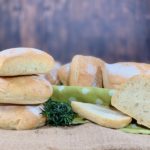Herb Sourdough Ciabatta Rolls
These tangy and flavorful Herb Sourdough Ciabatta Rolls are perfect for sandwiches or just as a side dish dipped in olive oil. You control the flavors to match your preferred cuisine!Adapted from King Arthur Flour
Servings: 12 rolls
Calories: 273kcal
Equipment
- stand mixer fitted with a dough hook
- bench scraper
- half sheet baking pans (2)
- Silpat silicone mat or parchment paper
- large frying pan
- spray bottle
Ingredients
- 6 to 7 cups all purpose flour (25-½ oz to 30 oz, 723g to 844g)
- 1 cup sourdough starter (8-½ oz, 225g) fed or unfed, room temperature (see Recipe Notes)
- 1-¼ cups water (10 oz, 283g) lukewarm
- ¾ cup milk (6 oz, 170g) lukewarm
- 1 tablespoon olive oil (½ oz, 14g)
- 1 tablespoon salt
- 1 tablespoon mixed herbs chopped (see Recipe Notes)
- 2 teaspoon yeast
Instructions
- In the bowl of a stand mixer, mix all the dough ingredients together, using 6 cups (25-½ oz, 723g) of the flour. Knead the dough with the dough hook (or turn onto a lightly floured work surface to knead by hand) until you have a smooth, yet slack dough. Add more flour only as necessary in two tablespoon increments to make a smooth, satiny, elastic dough. The dough should definitely be on the slack side, but not oozy (see Recipe Notes).
- Place the dough in an oiled bowl and cover. Let it rise in a warm spot for about 1-2 hours, or until it doubles in size. You can use a controlled-temperature bread proofer or just the oven with the light turned on.
- Gently deflate the dough and turn it onto a lightly floured work surface.
- Pat the dough into a rectangle about 9- x 16-inches. Cut into twelve 3- x 4-inch rolls using a bench scraper or chef’s knife. Try to make the rolls approximately the same size, but don’t stress about exact measurements.
- Place the rolls on two half sheet baking pans lined with Silpat silicone mats or parchment paper, six to a sheet. Space the rolls a little…they'll need room for expansion. Cover the rolls with a towel and let them rise until puffy, about 30 minutes.
- While the rolls rise, preheat the oven to 425°F. Place a large frying pan filled with water in the bottom of the oven (off to one side). The water will warm while the oven is heating, creating a steamy environment so the crusts gets nice and brown.
- Spray the loaves with water and sift a thin layer of flour on top. Bake the rolls for 15 minutes, then rotate the baking sheets, working quickly (see Recipe Notes). Lower the oven temperature to 375°F, and bake for an additional 15 to 20 minutes, until the rolls are a deep golden brown.
- Remove the rolls from the oven, turn off the oven, and return the rolls to the oven with its door cracked open a couple of inches. Let rolls cool completely in the cooling oven.
Notes
- Using fed sourdough starter might give you a better rise (depending on how vigorous your starter is), but using unfed sourdough starter discard works just fine.
- Use any combination of herbs you prefer. Italian herbs could include rosemary, oregano, basil, but you can use other combinations like sage and thyme or herbs de Provence. You can use either fresh, dried, or a mixture of the two.
- To achieve a ciabatta’s open, airy crumb, the dough needs to be slack, but the rolls also need to be able to hold their shape in the oven. Too much flour will yield rolls with a texture that doesn’t have those holes. Not enough flour and the rolls just flatten out. This is a trial-and-error process, people, so just…uhm…roll with it.
- I always rotate my baking sheets (front to back and switching racks) halfway through the cooking time. If you decide to do that, work quickly so you don’t lose too much steam in the process.
- In order to get that nicely browned exterior, add a large skillet filled with about two cups of water to the oven before you start to preheat it. The warming oven will heat the water. Just be careful when you open the oven to put in the dough or you’ll get a faceful of steam (and this isn’t spa day).
- Speaking of preheating the oven, let it heat for and additional 30 minutes or more after it tells you it’s ready to make sure the entire oven is uniformly hot. This will help the loaves spring up no matter which rack the baking pans are on.
- A word about flour amounts...to achieve a ciabatta’s open, airy crumb, the dough needs to be slacker than a normal white bread, but the rolls also need to be able to hold their shape in the oven. Too much flour will yield rolls with a texture that doesn’t have those holes. Not enough flour and the rolls just flatten out. Start with the lesser amount of flour and add more in two tablespoon increments.
Nutrition
Serving: 1roll | Calories: 273kcal | Carbohydrates: 53g | Protein: 8g | Fat: 2g | Saturated Fat: 1g | Cholesterol: 2mg | Sodium: 591mg | Potassium: 106mg | Fiber: 2g | Sugar: 1g | Vitamin A: 53IU | Vitamin C: 1mg | Calcium: 27mg | Iron: 3mg
